You need to configure the Group Policy settings to ensure that the Azure Virtual Desktop session hosts meet the security requirements. What should you configure?
You need to meet the technical requirements for Server4.
Which cmdlets should you run on Server1 and Server4? To answer, select the appropriate options in the answer area.
NOTE: Each correct selection is worth one point.
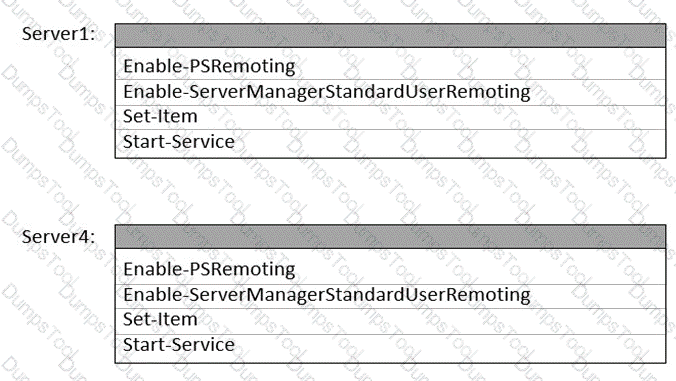
You need to meet the technical requirements for VM3
On which volumes can you enable Data Deduplication?
Which groups can you add to Group3 and Group5? To answer, select the appropriate options in the answer area.
NOTE: Each correct selection is worth one point.
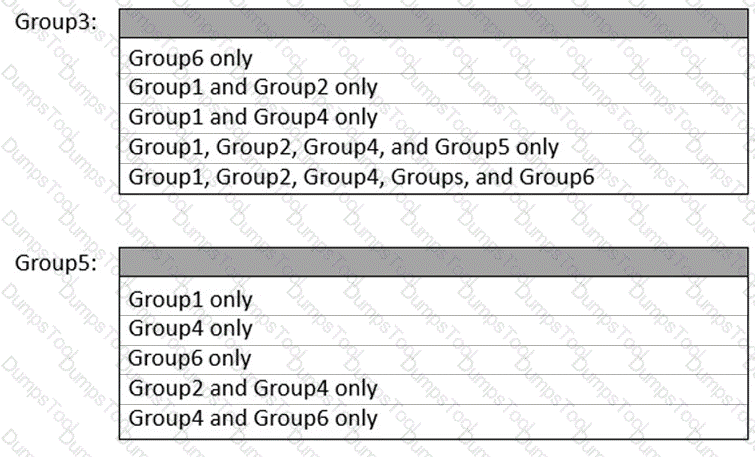
You need to meet the technical requirements for User1. The solution must use the principle of least privilege.
What should you do?
You need to implement the planned changes for Microsoft Entra users to sign in to Server1.
Which PowerShell cmdlet should you run?
For each of the following statements, select Yes if the statement is true. Otherwise, select No.
NOTE: Each correct selection is worth one point.

You need to implement the planned changes for the Azure DNS Private Resolver.
Which private DNS zones can you use for name resolution?
You need to ensure that Automanage meets the technical requirements.
On which Azure virtual machines should you enable Automanage?
You need to implement the planned change for Data1.
Which actions should you perform in sequence? To answer, drag the appropriate actions to the correct order. Each action may be used once, more than once, or not at all. You may need to drag the split bar between panes or scroll to view content.
NOTE: Each correct selection is worth one point.

You need to ensure that VM3 meets the technical requirements.
What should you install first?
You need to meet technical requirements for HyperV1.
Which command should you run? To answer, select the appropriate options in the answer area.
NOTE: Each correct selection is worth one point.

You need to ensure that access to storage1 for the Marketing OU users meets the technical requirements.
What should you implement?
DC1 fails.
You need to meet the technical requirements for the schema master.
Yourunntdsutil.exe.
Which five commands should you run in sequence? To answer, move the appropriate commands from the list of commands to the answer area and arrange them in the correct order?

Your on-premises network contains an Active Directory Domain Services (AD DS) domain. The domain contains the servers shown in the following table.

The domain controllers do NOT have internet connectivity.
You plan to implement Azure AD Password Protection for the domain.
You need to deploy Azure AD Password Protection agents. The solution must meet the following requirements:
• All Azure AD Password Protection policies must be enforced.
• Agent updates must be applied automatically.
• Administrative effort must be minimized.
What should you do? To answer select the appropriate options in the answer area.
NOTE: Each correct selection is worth one point.

You need to sync files from an on premises server named Server1 to Azure by using Azure File Sync.
You have a cloud tiering policy that is configured for 30 percent free space and 70 days.
Volume E on Server1 is 500 GB.
A year ago, you configured E:\Data on Server1 to sync by using Azure File Sync. The files that are visible in E:\Data are shown in the following table.

Volume E does NOT contain any other files.
Where are File1 and File3 located? To answer, select the appropriate options in the answer area.
NOTE: Each correct selection is worth one point.
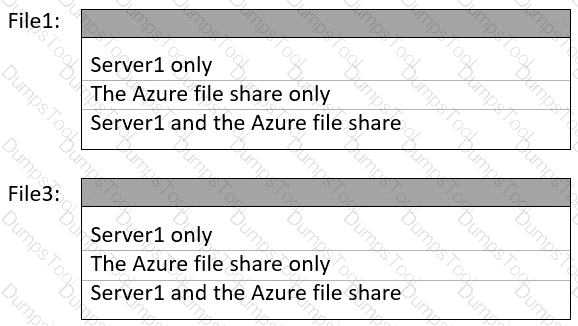
You have an Azure virtual machine named VM1 that runs Windows Server.
You have an Azure subscription that has Microsoft Defender for Cloud enabled.
You need to ensure that you can use the Azure Policy guest configuration feature to manage VM1.
What should you do?
You have a Group Policy Object (GPO) named GPO1 that contains user settings only.
You plan to apply GPO1 to a global security group named Group1.
You link GP01 to the domain, and you remove all the permissions granted to the Authenticated Users group.
You need to configure permissions for GP01 to meet the following requirements.
• GPO1 must apply only to the users in Group 1.
• The solution must use the principle of least privilege

Your network contains an Active Directory Domain Services (AD DS) forest named contoso.com. The forest contains the servers shown in the following table.
Server 1 hosts the DNS zone tor contoso.com. The General tab of the eontoso.com properties is configured as shown in the following exhibit.
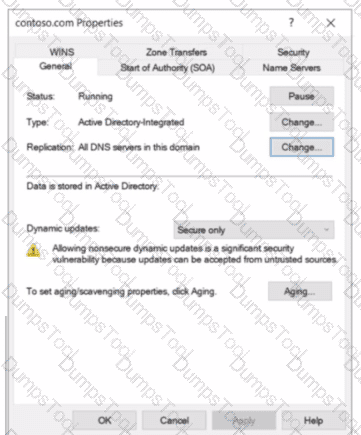
Server3 hosts the DNS zone for east.contoso.com and is configured as shown in the following exhibit.
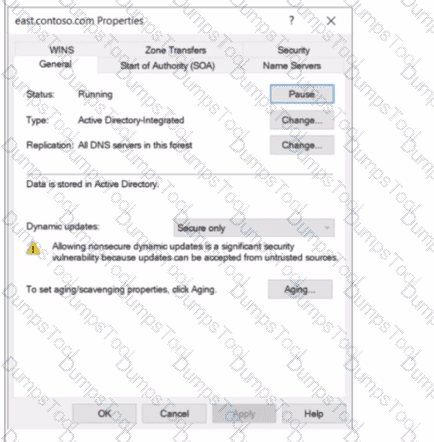
for each of the following statements, select Yes if the statement is true. Otherwise, select No.
NOTE: Each correct selection is worth one point.

You have an Azure Active Directory Domain Services (Azure AD DS) domain.
You create a new user named Admin1.
You need Admin1 to deploy custom Group Policy settings to all the computers in the domain. The solution must use the principle of least privilege.
What should you include in the solution? To answer, select the appropriate options in the answer area.
NOTE: Each correct selection is worth one point

Your network contains two Active Directory Domain Services (AD DS) forests named contoso.com and fabrikam.com. A two-way forest trust exists between the forests. Each forest contains a single domain. The domains contain the servers shown in the following table.

You need to configure resources based constrained delegation so that the users In contoso.com can use Windows Admin Center on Server) to connect to Server? How should you complete the command? To answer, select the appropriate options in the answer area. NOTE: Each correct selection is worth one point.

You have a server named Server1 that runs Windows Server. The disks on Server1 are configured as shown in the following exhibit.
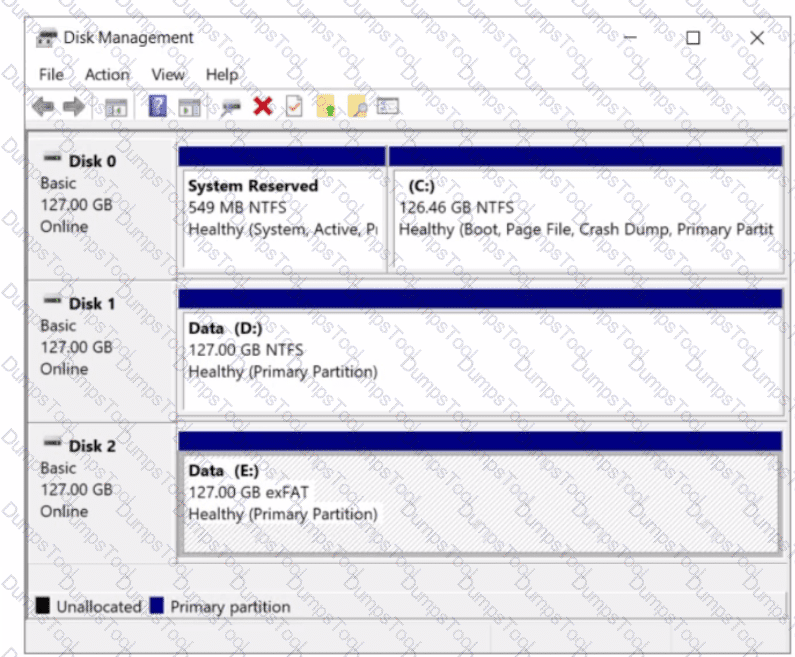
You need to convert volume E to ReFS. The solution must meet the following requirements:
• Preserve the existing data on volume E.
• Minimize administrative effort.
What should you do first?
Your network contains an Active Directory Domain Services {AD DS) domain. The domain contains the resources shown in the following table.

You plan to replicate a volume from Server1 to Server2 by using Storage Replica.
You need to configure Storage Replica.
Where should you install Windows Admin Center?
You have a server named Server1 that hosts Windows containers. You plan to deploy an application that will have multiple containers. Each container will be You need to create a Docker network that supports the deployment of the application. Which type of network should you create?
Your network contains an Active Directory Domain Services (AD DS) forest named contoso.com. The forest contains a child domain named east.contoso.com.
in the contoso.com domain, you create two users named Admin1 and Admin2.
You need to ensure that the users can perform the following tasks:
• Admin1 can create and manage Active Directory sites.
• Admin2 can deploy domain controller to the easl.conloso.com domain.
The solution must use the principle of least privilege.
To which group should you add each user? To answer, select the appropriate options in the answer area.
NOTE Each correct selection is worth one point.

Your network contains an Active Directory Domain Services (AD DS) forest. 1 he forest contains the groups shown in the following table.

You need to implement a group nesting strategy.
Which groups can be added as members of Group12, and which groups can be added as members of Group21? To answer, select the appropriate options in the answer area.
NOTE: Each correct selection is worth one point.
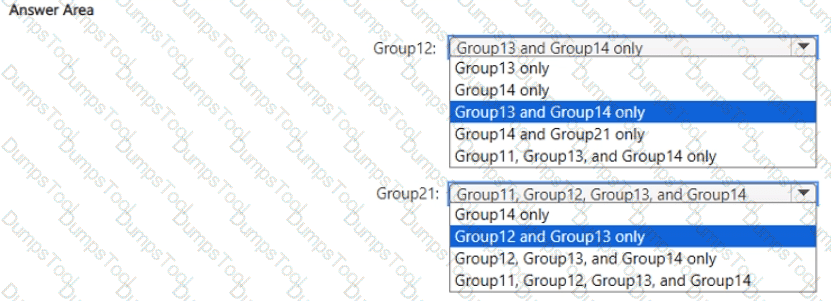
You have an on-premises network that is connected to an Azure virtual network by using a Site-to-Site VPN. Each network contains a subnet that has the same IP address space. The on-premises subnet contains a virtual machine.
You plan to migrate the virtual machine to the Azure subnet.
You need to migrate the on premises virtual machine to Azure without modifying the IP address. The solution must minim administrative effort.
What should you implement before you perform the migration?
You deploy a single-domain Active Directory Domain Services (AD DS) forest named contoso.com.
You deploy five servers to the domain. You add the servers to a group named iTFarmHosts.
You plan to configure a Network Load Balancing (NIB) cluster named NLBCluster.contoso.com that will contain the five servers.
You need to ensure that the NLB service on the nodes of the cluster can use a group managed service account (gMSA) to authenticate.
Which three PowerShell cmdlets should you run in sequence? To answer, move the appropriate cmdiets from the list of cmdlets to the answer area and arrange them in the correct order.

You need to sync files from an on-premises server named Server1 to Azure by using Azure File Sync
You have a cloud tiering policy that is configured for 30 percent free space and 70 days.
Volume f on Server1 is 500 GB.
A year ago. you configured E:\Oata on Server1 to sync by using Azure File Sync. The files that are visible in E:\Data are shown in the following table.

Volume E does NOT contain any other files.
Where are File1 and flle3 located? To answer, select the appropriate options In the answer area.

Task 1
You need to prevent domain users from saving executable files in a share named \\SRVl\Data. The users must be able to save other files to the share.
Task2
You need to ensure that the Azure file share named share1 can sync to on-premises servers.
The required source files are located in a folder named \\dc1.contoso.com\install.
You do NOT need to specify the on-premises servers at this time.
Task 5
You have an application that is copied to a folder named C:\app on SRV1. C:\app also contains also a Dockerfile for the app.
On SRV1. you need to create a container image for the application by using the Dockerfile. The container image mutt be named app1.
Task 11
You need to ensure that all DHCP clients that get an IP address from SRV1 will be configured to use DC1 as a DNS server.
Task 4
You need to register SRV1 to sync Azure file shares The registration must use the 34646045 Storage Sync Service.
The required source files are located in a folder named \\dc1.contoso.com\install.
You do NOT need to configure file share synchronization at this time and you do NOT need to update the agent.
You need to meet the security requirements for passwords.
Where should you configure the components for Azure AD Password Protection? lo answer, drag the appropriate components to the correct locations. Each component may be used once, more than once, or not at all. You may need to drag the split bar between panes or scroll to view content.
NOTE Each correct selection is worth one point.

You need to configure network communication between the Seattle and New York offices. The solution must meet the networking requirements.
What should you configure? To answer, select the appropriate options in the answer area.
NOTE: Each correct selection is worth one point.
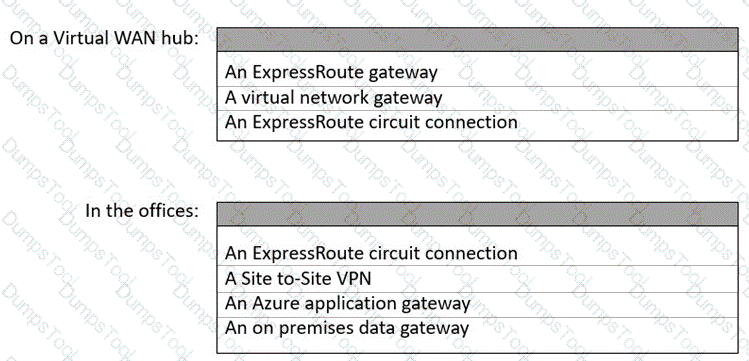
Which three actions should you perform in sequence to meet the security requirements for Webapp1? To answer, move the appropriate actions from the list of actions to the answer area and arrange them in the correct order.
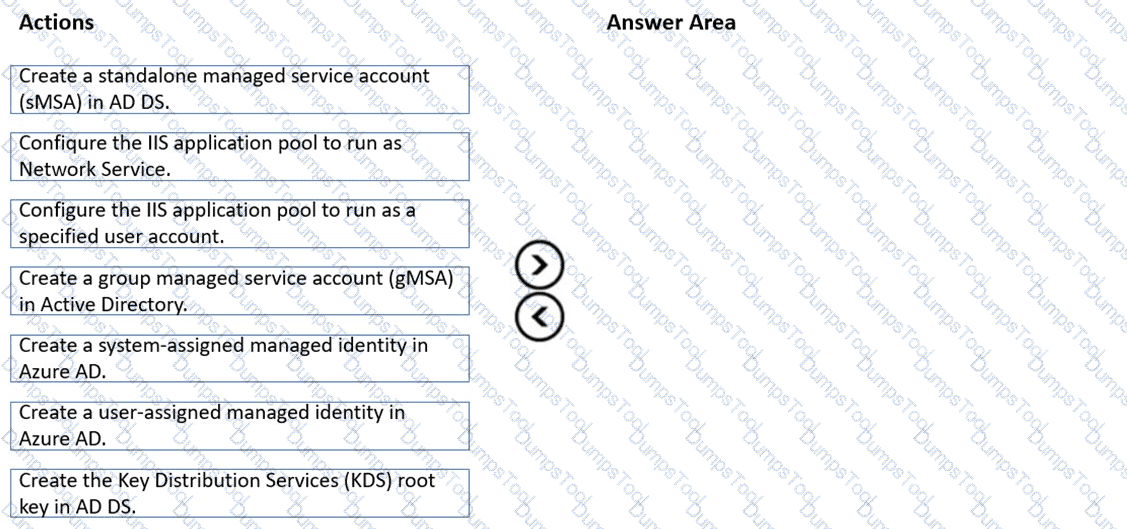
You need to configure Azure File Sync to meet the file sharing requirements. What should you do? To answer, select the appropriate options in the answer area. NOTE Each correct selection is worth one point.

You need to configure remote administration to meet the security requirements. What should you use?
You are planning the implementation Azure Arc to support the planned changes. You need to configure the environment to support configuration management policies. What should you do?